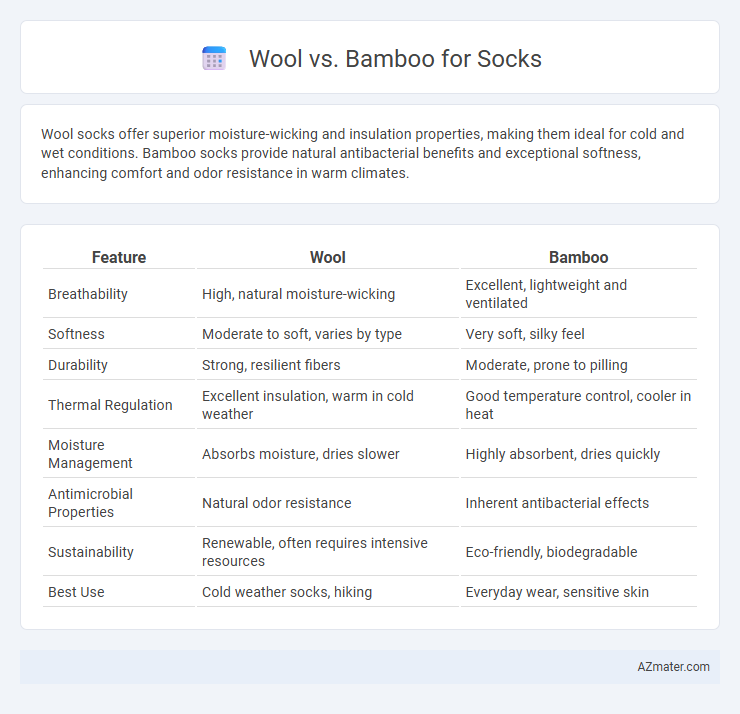Wool socks offer superior moisture-wicking and insulation properties, making them ideal for cold and wet conditions. Bamboo socks provide natural antibacterial benefits and exceptional softness, enhancing comfort and odor resistance in warm climates.
Table of Comparison
| Feature | Wool | Bamboo |
|---|---|---|
| Breathability | High, natural moisture-wicking | Excellent, lightweight and ventilated |
| Softness | Moderate to soft, varies by type | Very soft, silky feel |
| Durability | Strong, resilient fibers | Moderate, prone to pilling |
| Thermal Regulation | Excellent insulation, warm in cold weather | Good temperature control, cooler in heat |
| Moisture Management | Absorbs moisture, dries slower | Highly absorbent, dries quickly |
| Antimicrobial Properties | Natural odor resistance | Inherent antibacterial effects |
| Sustainability | Renewable, often requires intensive resources | Eco-friendly, biodegradable |
| Best Use | Cold weather socks, hiking | Everyday wear, sensitive skin |
Introduction: Wool vs Bamboo Socks
Wool socks offer excellent insulation, moisture-wicking properties, and natural antimicrobial benefits, making them ideal for cold and damp conditions. Bamboo socks provide superior softness, breathability, and hypoallergenic qualities, suitable for sensitive skin and warm climates. Both materials prioritize comfort and durability but cater to different environmental and personal needs.
Material Composition and Sources
Wool socks primarily derive from sheep, especially Merino breeds, offering natural moisture-wicking and insulation due to lanolin content and crimped fibers. Bamboo socks come from bamboo pulp processed into viscose or rayon, providing a soft, breathable, and hypoallergenic fabric with inherent antimicrobial properties. Wool's renewable animal fiber contrasts with bamboo's rapidly renewable plant source, influencing sustainability and texture in sock manufacturing.
Comfort and Softness Comparison
Wool socks provide excellent insulation and moisture-wicking properties, making them comfortable for cold weather but sometimes coarse against sensitive skin. Bamboo fibers offer superior softness and breathability, enhancing comfort particularly in warm or humid conditions due to their smooth texture and natural antibacterial qualities. Choosing between wool and bamboo for socks depends on personal sensitivity and climate, with wool excelling in warmth and bamboo in lightweight softness.
Moisture-Wicking Abilities
Wool fibers naturally excel in moisture-wicking, absorbing up to 30% of their weight in moisture while remaining dry to the touch, making them ideal for temperature regulation in socks. Bamboo fabric also offers strong moisture-wicking properties due to its micro-gaps and hollow fiber structure, which promote breathability and quick drying. Comparing the two, wool provides superior odor control and warmth retention during intense activity, whereas bamboo excels in softness and airflow, enhancing comfort in humid conditions.
Breathability and Temperature Control
Wool offers superior breathability and natural moisture-wicking properties that regulate foot temperature by absorbing and releasing moisture, keeping feet dry and comfortable in varied climates. Bamboo fibers excel in ventilation due to their porous structure, providing excellent airflow and quick-drying capabilities that prevent overheating. Wool's temperature control adapts dynamically to cold and warm conditions, while bamboo maintains a consistent cool feel, making both materials ideal for seasonal sock wear.
Durability and Longevity
Wool socks offer exceptional durability due to their natural resilience and elasticity, retaining shape and insulating properties even after extensive wear. Bamboo socks, while softer and more breathable, typically exhibit moderate durability but benefit from anti-microbial and moisture-wicking features that help maintain fabric integrity over time. Choosing wool provides longer-lasting wear in demanding conditions, whereas bamboo suits those prioritizing comfort with reasonable longevity.
Eco-Friendliness and Sustainability
Bamboo socks offer superior eco-friendliness due to bamboo's rapid growth and minimal pesticide requirements, making it a highly sustainable resource. Wool socks provide natural biodegradability and renewable qualities but involve higher water usage and methane emissions from sheep farming. Choosing bamboo reduces environmental impact through lower resource consumption and faster biodegradation compared to traditional wool production.
Odor Resistance in Wool vs Bamboo
Wool socks are highly effective in odor resistance due to lanolin, a natural antimicrobial agent that inhibits bacterial growth responsible for bad smells. Bamboo socks also offer odor resistance through bamboo charcoal fibers that absorb moisture and neutralize odor-causing bacteria. While both materials provide odor control, wool's inherent antibacterial properties generally outperform bamboo, making it a preferred choice for long-lasting freshness in socks.
Allergies and Skin Sensitivity
Wool socks, especially those made from merino wool, are naturally moisture-wicking and antimicrobial but may cause irritation or allergic reactions in individuals with sensitive skin or lanolin allergies. Bamboo socks offer a hypoallergenic alternative, being softer and less likely to cause itching or rashes due to their natural antibacterial and breathable properties. Both materials provide comfort, but bamboo is often preferred by people prone to skin sensitivity or allergic reactions.
Price and Value for Money
Wool socks generally come at a higher price point due to their natural insulation, durability, and moisture-wicking properties, offering excellent value for outdoor activities and cold weather. Bamboo socks, being more affordable, provide good softness, breathability, and antibacterial benefits, making them a cost-effective option for everyday wear. Choosing between wool and bamboo socks depends on whether premium thermal performance or budget-friendly comfort is the priority.

Infographic: Wool vs Bamboo for Sock
 azmater.com
azmater.com